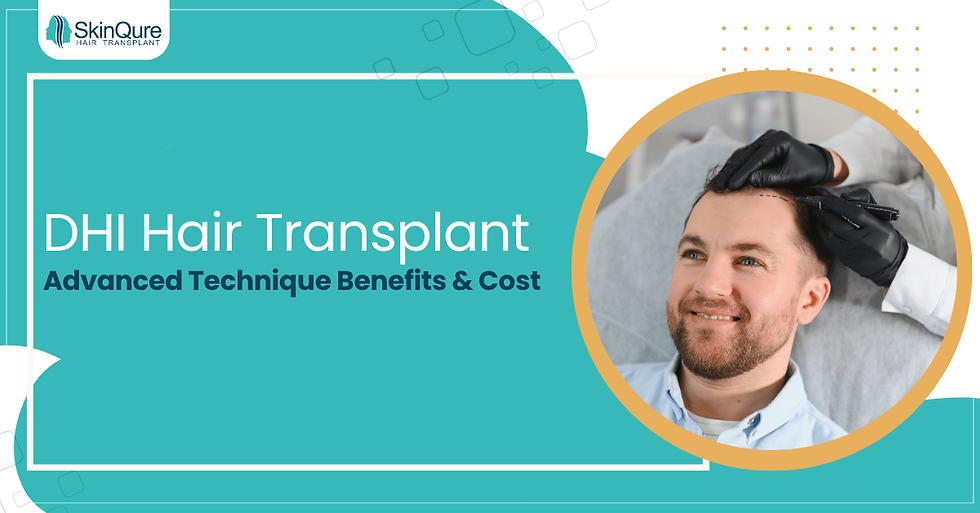5 Things To Consider Before Planning For Hair Transplant After Chemotherapy
- Dr Jangid, MD
- Feb 15, 2024
- 3 min read
Updated: Apr 25, 2024
Stepping into the world of hair restoration after going through chemotherapy is a big decision, and we understand that. Your appearance means a lot – it's what makes you feel confident and happy. Cancer treatment is tough, changing a lot about how you look and feel about yourself. After facing those challenges, many of us want to get back to feeling normal or self-assured, and that often includes thinking about our hair.
In this short blog, we'll talk about the possibilities and things to consider when it comes to getting a hair transplant after chemotherapy. Read on to know the 5 things you should consider before planning a transplant after chemotherapy:
1. Wait For Complete Recovery
It's advised to wait until you've fully recovered from chemotherapy before considering a hair transplant. Hair transplant surgery is typically not recommended during active cancer treatment.
2. Assess Your Hair Regrowth
After chemotherapy, it's important to allow time for your natural hair to regrow. This may take several months, and the extent of regrowth can vary from person to person.
3. Consultation With A Specialist
Before undergoing a hair transplant, you should consult with a qualified hair transplant surgeon in Delhi. They can assess your overall health, the condition of your scalp, and the feasibility of the procedure.
4. Potential Scarring
Chemotherapy can affect the quality of your scalp and may impact the healing process after a hair transplant. Your surgeon will evaluate your scalp condition and discuss any potential scarring concerns.
5. Consideration Of Other Options
Depending on the extent of your hair loss and the condition of your scalp, you may also want to consider other hair restoration options, such as non-surgical treatments or partial hairpieces.
Know About Non-Surgical Hair Restoration Techniques
Several non-surgical hair restoration techniques are available for individuals looking to address hair loss without undergoing surgery. Here are some common options:
1. Topical Treatments
Minoxidil: A topical solution applied directly to the scalp to stimulate hair growth. Finasteride: An oral medication that inhibits the effects of dihydrotestosterone (DHT), a hormone linked to hair loss.
2. Low-Level Laser Therapy (LLLT)
Individuals looking for hair restoration after chemotherapy can opt for devices such as laser caps containing low-level lasers or light-emitting diodes (LEDs) worn on the scalp to stimulate hair follicles.
3. Platelet-Rich Plasma (PRP) Therapy
Involves extracting a small amount of the patient's blood, processing it to concentrate platelets, and then injecting the PRP into the scalp to stimulate hair growth. As of now, Dr. Jangid from SkinQure is the best surgeon for both Invasive and non-invasive hair restoration procedures.
4. Nutritional Supplements
It is highly recommended to start taking supplements containing vitamins and minerals, such as biotin and zinc. They are believed to support hair health for the long-term.
5. Mesotherapy
Mesotherapy is a non-invasive procedure which Involves injecting a mixture of vitamins, minerals, and other nutrients into the scalp to stimulate hair growth. The result depends on individual to individual, considering their overall health.
It's important to note that the effectiveness of these non-surgical techniques can vary among individuals, and results may take time to become noticeable. Consulting with a healthcare professional or a specialist in hair restoration can help determine the most suitable approach based on individual needs and conditions.
Conclusion
It's crucial to approach post-chemotherapy hair transplants with careful consideration and under the guidance of experienced Hair restoration specialists . Your individual circumstances and health conditions will play a significant role in determining the best course of action. Always consult with hair experts, including oncologists and hair transplant specialists like Dr Jangid, to make informed decisions based on your health and recovery status. We wish you all the best for your hair restoration journey!










Comments